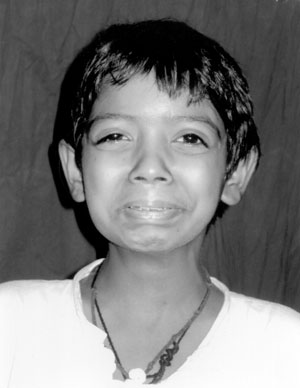O
choa or Urofacial syndrome is a
rare syndrome with over 100 cases reported world over(1). It is an
autosomal recessive condition characterised by hydronephrosis with
peculiar facial expression due to abnormal nerve signals between bladder
and spinal cord. Here we report the first case of this syndrome from
India.
Case Report
A 10 year old boy was admitted for fever and tachypnea
for 10 days. The patient had no other respiratory or cardiac complaints.
On examination, he had tachycardia and tachypnoea with acidotic breathing,
the blood pressure was 142/96 mm Hg in the right arm supine position. The
patient was wasted, stunted and showed severe pallor with signs of
vitamins A and vitamin B deficiency. There was a peculiar facial
expression characterised by inverted facial smile with no facial asymmetry
(Fig. 1). There was history of similar facial expression in
maternal grandfather. There were no other systemic findings. The
haemoglobin level was 5.8 g/dL, peripheral smear showed normochromic
normocytic anemia. The blood pH was 7.16, bicarbonate 5.1 mEq/l/L, blood
urea 136 mg/dL and creatinine 3.5 mg/dL; Ultrasonography of abdomen showed
bilateral moderate hydronephrosis with hydroureter and thickened and
trabeculated bladder wall, suggestive of obstructive uropathy. A
micturating cystourethrogram showed features suggestive of neurogenic
bladder. Urodyna-mic study showed urge incontinence, hypocontractile
detrusor with post void residual urine and reduced maximum and average
flow rates suggestive of neurogenic bladder. DMSA and DTPA study showed
bilateral impaired cortical function with significantly delayed excretion
from both the kidneys. MRI brain and spine was within normal limit.
Patient was managed for chronic renal failure and subsequently treated
with clean intermittent catheterization (CIC), antibiotic prophylaxis and
anticholinergic therapy.
 |
|
Fig.1 Ochoa Syndrome. |
Discussion
Ochoa or Urofacial Syndrome is characterized by an
abnormal facial expression and obstructive disease of the urinary tract
that are present at birth(2). It occurs due to disruption (loss of
functional genes) or mutations of a gene on 10q23-q24(3). Patient may
develop renal failure in adolescence. The urinary abnormality is an
obstructive uropathy in which failure of nerve signals between the bladder
and the spinal cord results in incomplete emptying of the bladder(3). In
addition, neurogenic bladder may result in incontnence, urinary tract
infections, and/or hydronephrosis. Patients show a peculiar facial
expression; on smiling their facial musculature turns upside down or
"inverts" so that they appear to be grimacing or crying(3). Some patients
have unilateral facial palsy and two thirds have moderate to severe
constipation(4). Cryptorchidism may be an associated finding.
To map the UFS gene, a genome screen using a
combination of homozygosity-mapping and DNA-pooling strategies are
required. The management includes appropriate medical treatment for
chronic renal failure and urinary tract infection and management for
obstructive uropathy.
Contributors: MKA and RK drafted the manuscript and
searched the literature. MKA and NRS contributed to patient management.
MKA will act as guarantor.
Funding: None.
Competing interests: None stated.
References
1. Ochoa B. Can a congenital dysfunctional bladder be
diagnosed from a smile? The Ochoa syndrome updated. Pediatr Nephrol 2004;
19: 6-12.
2. Ochoa B, Walker RD, She JX. Homozygosity and
linkage- disequilibrium mapping of the urofacial (Ochoa) syndrome gene to
a 1-cM interval on chromosome 10q23-q24. Am J Human Genet 1997; 60:
1461-1467.
3. Urofacial Syndrome. National Organization for Rare
Disorders(Online). Available from URL http://www.rarediseases.org/search/rdblist.html.
Accessed March 31, 2009.
4. Ochoa B, Gorlin R, Opitz J. Urofacial (Ochoa) syndrome. Am J Med
Genet 1987; 27: 661-667.

